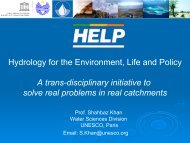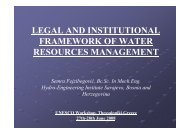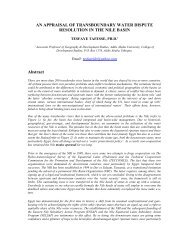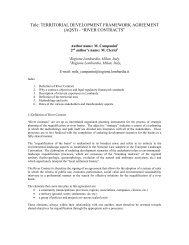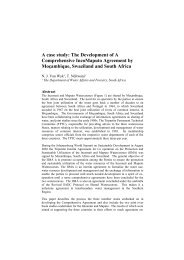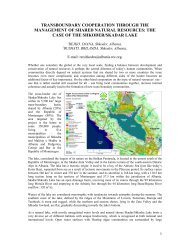Download the presentation (PDF) - inweb
Download the presentation (PDF) - inweb
Download the presentation (PDF) - inweb
- No tags were found...
You also want an ePaper? Increase the reach of your titles
YUMPU automatically turns print PDFs into web optimized ePapers that Google loves.
IV International Symposium on Transboundary Waters ManagementThessaloniki, Greece15 th -18 th October 2008Management ofMicro Prespa’s lake –environmental impacts andperspectivesProf. Dr. Sabri Laçi & MA Edlira KolaUniversity of Tirana, Department of Geography
IntroductionPrespa Region: located in <strong>the</strong> intersection of <strong>the</strong> borders of Albania,Greece and FYROM.Main important water bodies: Micro Prespa and Macro Prespa. 850 m above <strong>the</strong> sea level; current joint surface 313 km²; 5,227 inhabitants in dwellings with a distance of 3-5 km between<strong>the</strong>m;The Albanian part of <strong>the</strong> Micro Prespa: 8.5% of <strong>the</strong> lake overall surface; 5 km long and up to 3.7 km wide; belongs to <strong>the</strong> Bilisht and Proger commune of Devoll district; 3 closest villages: Shyec, Zagradec, Tren; only 20 persons/km 2 ;
Built up area around Micro Prespa Lake
Nature environment and human impactsThe livelihood of <strong>the</strong> villages around <strong>the</strong> lake is stronglydepended on <strong>the</strong> wellbeing of <strong>the</strong> lake as a source ofdrinking and cleaning water, fishing, irrigation, feeding etc.During socialist times: intervention to bring Devoll waterinto <strong>the</strong> Micro Prespa Lake in wintertime and constructionof Ventroku Canal to take water from <strong>the</strong> lake to irrigate<strong>the</strong> Korca Field in summertime.Increasing of solid depositions at <strong>the</strong> bottom of <strong>the</strong> lake(1.2 million m 3 in <strong>the</strong> last 25 years), reduction of waterlevel, decreasing of transparency and damaging of <strong>the</strong> fishspawning grounds.Transformation of a part of <strong>the</strong> lake into marshland.
High biodiversity of Prespa basin: 50 animal species and 19 plant species that areendemic to <strong>the</strong> Prespa watershed. 266 species of birds in <strong>the</strong> Prespa basin (91 of<strong>the</strong>m migratory species). endemic species of mollusks, arthropods,fishes, insects etc.
Treni caveRocky mummies of TrenCarstic caveLime rocks carved by carstScientific, archaeological, es<strong>the</strong>ticand tourist values.Scientific, didactic, es<strong>the</strong>tic andtourist values.Geo-monumentGeo-monument
Wetland or wasteland?Micro Prespa Lake: evidence of eutrification processsince three decades, although <strong>the</strong> limitedmonitoring.Following <strong>the</strong> definition of wetlands by <strong>the</strong> RamsarConvention: “Areas of marsh, fen, peat land orwater, whe<strong>the</strong>r natural or artificial, permanent ortemporary, with water that is static or flowing, fresh,brackish or salt, including areas of marine water, <strong>the</strong>depth of which at low tide does not exceed 6 m”,due to a process of degradation <strong>the</strong> Albanian part ofMicro Prespa Lake is becoming a lacustrine wetland(area of permanent water with little flow).Current depth in <strong>the</strong> Albanian part: up to only 2 m.
Marsh area at Micro Prespa Lake
1999: Prespa region was given <strong>the</strong> status of NationalPark (27,750 ha).2000: signing of "Declaration on <strong>the</strong> creation of <strong>the</strong>Prespa Park and <strong>the</strong> Environmental Protection andSustainable Development of <strong>the</strong> Prespa Lakes and <strong>the</strong>irsurroundings” by <strong>the</strong> Prime Ministers of Albania, Greeceand FYROM.2002: signing of a Memorandum of Understanding andCooperation in <strong>the</strong> field of environmental protectionbetween <strong>the</strong> Ministry for <strong>the</strong> Environment, PhysicalPlanning and Public Works of <strong>the</strong> Hellenic Republic and<strong>the</strong> Ministry of Environment of <strong>the</strong> Republic of Albania.
Law no.8906, dt. 6.6.2002 “On <strong>the</strong> protected areas” describes <strong>the</strong>National Park as “Wide territories no less than 1000 hectares, havingunique national and international values, a major part of which arenatural ecosystems, little affected by human activity, where plants,animals and natural physical environment are of a specialeducational and scientific importance”.Within <strong>the</strong> national park <strong>the</strong> following activities are prohibited: intensive land use causing fundamental or irreversible changes tobiodiversity, ecosystems and land cover; disposal of outside wastes in <strong>the</strong> territory of <strong>the</strong> national park; construction of roads, motor-ways, railways, urban areas, lines ofhigh voltage; circulation of transport means out of <strong>the</strong> approved roads; mining of minerals, stones, peat; mass sports and tourism activity outside <strong>the</strong> approved places etc.
Land categories in Prespa National Park (in ha)53722100Agricultural landForest areaPastures and m eadow area4950182813500Water areaUnproductive land, urban land, etc.The Prespa National Park is composed by :protected zone I (strictly protected area),protected zone II (managed zone),protected zone III (development zone) that includes <strong>the</strong>inhabited and agricultural areas of <strong>the</strong> Park andinfrastructure.
Agricultural landat Micro Prespa LakeForest coverat Micro Prespa Lake
The law no. 9103, dt. 10.7.2003 “On <strong>the</strong> protection oftransboundary lakes” calls for <strong>the</strong> development andimplementation of management plans, including all water basedactivities: fishery, forestry, agriculture, tourism, communication andindustry; local plans for rehabilitation; special monitoring programs.The following actions are prohibited in <strong>the</strong> transboundary lakesand in <strong>the</strong>ir watersheds: dumping, disposal or processing of any kind of waste; landscape affecting activities; lake water use without permitting; uncontrolled cutting of trees and forests; inappropriate utilization and burning of pastures; illegal fishing, hunting, collection of medicinal, tanipherous ande<strong>the</strong>r-oil plants, of snails, frogs, tortoises, and reptiles etc.
The economic assessment through integrationof ecological and economic approaches is anattempt to assign quantitative values to <strong>the</strong>goods and services provided by environmentalresources. The valuation needs to be directed towardssome policy issues, from simply raisingawareness of <strong>the</strong> importance of <strong>the</strong> wetlandsto choices among alternatives to meet somestated policy goal with protecting wetlands.
USE VALUESDirect use valueFish•Crabs•Eels•Alburnus alburnusprespensis),•carp (Cyprinuscarpio),•nose(Chondrostomaprespensis)•Leuciscuscephalusprespensis.•MollusksIndirect use valueNutrient retentionStorm protectionGroundwaterrechargeExternalecosystemsupportMicro-climaticstabilizationTable of Total Economic ValueOption and quasi-option valuePotential future uses (as perdirect and indirect uses)Future values of informationNON-USE VALUESExistence valueBiodiversity•Aquatic microflora (likens, ferus, etc.)•Barbus prerpemis (annex II and V of Dir. 92/43/EEC)•Alburnoides bipunctatus prespensis (annex II, as above)•Calcaburnus belvica•Paraphoxinus epiroticus (annex II, as above, endemic of <strong>the</strong>Balkans•Rutilus prespensis (annex II, as above)•Lutra lutra (under protection)•Pheasant•Boar•Wild dove•Pelecanus crispu - disappeared•Grouse•Ouzel•Nightingale•Woodpecker•Turtle dove•Hawk•Stork•Swallow•Wild gooses•Wild ducks•Otters•Bear•Wolf•Fox•Marten•Gazelle•Land reptiles (lizard, green adder, viper)•Deer•Plant resources (Papaver rhoeas, Orchis mascula, Malva sucvestris,Juniperus drycedrus, Hypericum perforatum, Crataegus monogyna,Chamomolla recutita, Betula pendula etc.)•2000-2500 kind of bats (Miniopterus scheibersi – endangeredspecies.
Table of Total Economic ValueUSE VALUESNON-USE VALUESDirect use valueIndirect usevalueOption and quasioptionvalueExistence valueAgriculture•Fruits•Vegetable•Wheat•Livestock•Bee growing•Viticulture•FruitsCulture, heritage•Treni cave•The rocky mummiesForests•Different kinds of pines•Juniper•Chestnut•Acacia•Bushes•Oak trees (Quercuspetrea, Quercus cerris,Quercus pubesceus,etc.)•Medicinal herbs•Forest fruitsFuel woodRecreation•Walking•Alpinism•Aquatic sports•Tourism•LandscapeBequest valuesTransportWildlife harvesting
The estimation of <strong>the</strong> above values isdifficult and only approximate.Never<strong>the</strong>less, this helps in <strong>the</strong> processof decision-making and rising <strong>the</strong>awareness on that environmental goodsare finite and have <strong>the</strong>ir own shadowprice.
Main results of meetings and questionnairesThe local communities highly appreciate <strong>the</strong> lake’svaluable functions: groundwater recharge,retention of pollutants, its products: fish, fuelwood, tourist attractions, and attributes:biodiversity, aes<strong>the</strong>tic beauty, cultural heritage andarchaeology.They are aware of <strong>the</strong> actual problems of <strong>the</strong> lakeand its surroundings and regret <strong>the</strong>irtransformation.The Willingness to Pay for <strong>the</strong> lake and itswetlands:an average of 100 ALL/person/month(1USD/person/month) = about 1,710,000 ALL/year(17,100 USD/year).
However approximate <strong>the</strong> figure may be, it givesan indication of <strong>the</strong> value of <strong>the</strong> Micro Prespawetland for <strong>the</strong> livelihood of <strong>the</strong> localcommunities and broader.It emphasizes <strong>the</strong> need forserious andsustainable interventions for improving <strong>the</strong>health of <strong>the</strong> wetland and <strong>the</strong> sustainablemanagement of <strong>the</strong> related eco-region.Therefore, <strong>the</strong> need for sustainable fund-risingand strict implementation of <strong>the</strong> national andinternational legal obligations mustbeconsidered as an urgent issue.
Thank youfor your attention!



